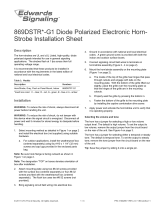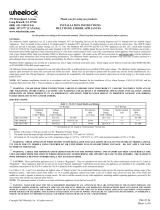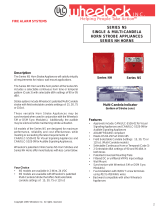Page is loading ...

D900-37-00 1 I56-2257-005R
For use with the following models:
Strobe - 12/24 volt: S1224MCK
Combo - 12/24 volt: P1224MCK
Horn - 12/24 volt: H12/24K
“K” model series are outdoor rated when installed with System Sensor WBB.
The Products to which this manual applies may be covered by one or more of the following U.S. Patent numbers:
5,914,665; 5,850,178; 5,598,139; 6,049,446; 6,133,843; 6,522,261; 6,661,337; 6,793,375; 6,822,400; 5,931,569; 6,833,783; 6,838,997;
INSTALLATION AND MAINTENANCE INSTRUCTIONS
3825 Ohio Avenue, St. Charles, Illinois 60174
1-800-SENSOR2, FAX: 630-377-6495
www.systemsensor.com
General Description
The SpectrAlert series notification appliances are designed to
meet the requirements of most agencies governing these devices,
including: NFPA, ADA, The National Fire Alarm Code, UL, and
ULC. Also, check with your local Authority Having Jurisdiction
for other codes or standards that may apply.
The SpectrAlert series can be installed in systems using 12- or 24-
volt panels having DC or full-wave rectified (FWR) power supplies.
The series can also be installed in systems requiring synchroniza
-
tion (module MDL or compatible equivalent required) or systems
that do not require synchronization (no module required).
NOTICE: This manual shall be left with the owner/user of this equipment.
Fire Alarm System Considerations
Temporal and Non-Temporal Coded Signals:
The American National Standards Institute and the National Fire
Alarm Code require that all horns used for building evacuation in
-
stalled after July 1, 1996, must produce Temporal Coded Signals.
Signals other than those used for evacuation purposes do not have
to produce the Temporal Coded Signal. Temporal coding is accom
-
plished by interrupting a steady sound in the following manner:
Specifications
Automatic selection for 12 or 24 volt rated operation (DC or Full-Wave Rectified)
Electrical
Horns, Strobes, and
Horn/Strobes Voltages: Regulated 12 DC/FWR and Regulated 24 DC/FWR
Operational Voltage Ranges: 12V=8-17.5 Volts; 24V=16-33 Volts
Synchronous Applications
with MDL Module: 12V=9-17.5 Volts; 24V=17-33 Volts
NOTE: Horn units will operate on walk tests with on-time durations of .25 sec. or greater.
Flash Rate: 1 flash per second
K Series Operating Temperature: Strobe, horn and horn/strobe models are indoor and outdoor listed, having a temperature
range of –40° F to 150.8° F (–40° C to 66° C)
All models are indoor/outdoor listed, strobes per UL 1971 and UL 1638, horns per UL 464.
Selectable Light Outputs: All candelas are selectable via a manual slide switch.
12/24 Volt Applications: 15 or 15/75 candela
24 Volt Application: 30, 75, 110 candela
15/75 is listed at 15 candela per UL 1971 but will provide 75 candela on axis (straight ahead).
15, 30, 75, or 110 are rated for that candela.
Sound Output: Sound output levels are established at Underwriters Laboratories in their reverberant room.
Always use the sound output specified as UL Reverberant Room when comparing products.
Listings: UL S3593/S5512 (Strobe); UL S4011 (Combo); UL 1638 and UL 1971 (Strobe); UL50 (Horn)
Note for Strobes: Do not exceed; 1) 8-17.5 or 16-33 voltage range limit; 2) maximum number of 70 strobe lights when connecting the MDL Sync module
with a maximum line impedance of 4 ohms per loop and; 3) maximum line impedance as required by the fire alarm control manufacturer.
The models
S1224MCK and P1224MCK
incorporate a patented voltage booster design that has a more consistent flash bulb voltage over the range of candela
selections. The benefit to the customer is a high quality strobe device.
Power Supply Considerations
Panels typically supply DC filtered voltage or FWR (full-wave
rectified) voltage. The system design engineer must calculate the
number of units used in a zone based on the type of panel supply.
Be certain the sum of all the device currents do not exceed the
current capability of the panel. Calculations are based on using
the device current found in the subsequent charts and must be
the current specified for the type of panel power supply used.
Wire Sizes
The designer must be sure that the last device on the circuit has
sufficient voltage to operate the device within its rated voltage.
When calculating the voltage available to the last device, it is nec
-
essary to consider the voltage drop due to the resistance of the
wire. The thicker the wire, the less the voltage drop. Generally, for
purposes of determining the wire size necessary for the system, it
is best to consider all of the devices as “lumped” on the end of the
supply circuit (simulates “worst case”).
1
/2 Sec.
On
1
/2 Sec.
Off
1
/2 Sec.
On
1
/2 Sec.
Off
1
/2 Sec.
On
1
1
/2 Sec.
Off
Repeats
SpectrAlert Selectable Output
Outdoor Strobes, Horn and Horn/Strobes

D900-37-00 2 I56-2257-005R
Typical wire size resistance:
18 AWG solid: Approximately 8 ohms/1,000 ft.
16 AWG solid: Approximately 5 ohms/1,000 ft.
14 AWG solid: Approximately 3 ohms/1,000 ft.
12 AWG solid: Approximately 2 ohms/1,000 ft.
Example: Assume you have 10 devices on a zone and each re
-
quires 50 mA average and 2000 Ft. of 14 AWG wiring (total
length=outgoing +return). The voltage at the end of the loop is
0.050 amps per device x 10 devices x 3 ohms/1,000 ft. x 2000 ft
=3 volts drop.
NOTE: If class “A” wiring is installed, the wire length may be up
to 4 times the single wire length in this calculation.
The same number of devices using 12 AWG wire will produce only
2 volts drop. The same devices using 18 AWG wire will produce
8 volts drop. Consult your panel manufacturer’s specifications, as
well as SpectrAlert’s operating voltage range to determine accept
-
able voltage drop.
Figure 1A: Current Draw Measurements (RMS)
NOTE: All ‘S’ and ‘P’ models were only tested at the 8-17.5 and
16-33 Volt-FWR/DC limits. This does not include the 80% low-
end or 110% high-end voltage limits.
Strobe Current Draw
Candela
Setting
FWR
Operating
Current
Strobe
DC
Operating
Current
Strobe
12V 24V 12V 24V
15
112 64 127 59
15/75
135 74 127 69
30
93 90
75
158 160
110
208 209
NOTE: 12 VDC 2-wire horn/strobe current is shown in Figure 1D.
24VDC 2-wire horn/strobe current draw is shown in Figure 1E.
Horn/Strobe current draw can be calculated by adding the strobe
current draw (Figure 1A) for chosen candela setting to the horn
current draw (Figure 1C) for chosen setting.
Figure 1B: Horn Sound Measurements (dBA):
Selectable Horn Tones
8-17.5V 16-33V
Temporal Low
Volume
Electromechanical 67 75
3000 Hz Interrupted 68 75
High
Volume
Electromechanical 71 80
3000 Hz Interrupted 72 81
Non-
Temporal
Low
Volume
Electromechanical
71 79
3000 Hz Interrupted 72 79
High
Volume
Electromechanical 76 84
3000 Hz Interrupted 77 86
Figure 1C: Horn Current Draw Measurements (RMS):
Selectable Horn Tones
DC FWR
12V 24V 12V 24V
Temporal Low
Volume
Electromechanical 15 23 13 23
3000 Hz Interrupted 15 33 13 23
High
Volume
Electromechanical 36 53 20 44
3000 Hz Interrupted 43 57 21 40
Non-
Temporal
Low
Volume
Electromechanical
16 37 19 29
3000 Hz Interrupted 16 32 18 33
High
Volume
Electromechanical 38 49 46 49
3000 Hz Interrupted 44 56 42 58
NOTE: Regulated 12 VDC, max operating current 44.4 mA
Regulated 24 VDC, max operating current 57.0 mA
12 V FWR, max operating current 45.7 mA
24 V FWR, max operating current 57.5 mA
Figure 1D: 12VDC Horn/Strobe Current Draw
Measurements (mA RMS)
Temporal
Low Volume High Volume
Candela
Setting
Electromechanical 3000 Hz Electromechanical 3000 Hz
15 111 111 112 112
15/75 127 127 126 129
Non-Temporal
15 113 112 114 115
15/75 128 128 130 134
Figure 1E: 24VDC Horn/Strobe Current Draw
Measurements (mA RMS)
Temporal
Low Volume High Volume
Candela
Setting
Electromechanical 3000 Hz Electromechanical 3000 Hz
15 71 70 73 75
15/75 86 85 87 88
30 99 98 100 100
75 166 166 167 170
110 209 209 210 213
Non-Temporal
15 74 74 79 82
15/75 86 88 93 96
30 101 101 107 110
75 167 167 173 176
110 213 213 218 222
Candela equivalent at –40°C and below:
15cd 3cd
15/75cd 20cd
30cd 9cd
75cd 27cd
110cd 46cd

System Operation – Non-Synchronized Devices:
Figure 4a. Any combination of models powered by a
2-wire circuit:
HORN
(+)
(–)
(+)
(–)
E
O
L
(+)
(–)
(+)
(–)
HORN/STROBE
STROBE ONLY
TWO WIRE SYSTEM
ANY MIX OF MODELS
WIRED FOR TANDEM
OPERATION
HORN
SYNCHRONIZATION MODULE
MDL
(+)
(–)
(+)
(–)
E
O
L
(+)
(–)
(+)
(–)
HORN/STROBE
STROBE ONLY
TWO WIRE SYSTEM
ANY MIX OF MODELS
WIRED FOR TANDEM
OPERATION
System Operation – Synchronized Devices:
Figure 4b. Any combination of models powered by a
2-wire circuit:
HORN
(+)
(–)
(+)
(–)
E
O
L
(+)
(–)
(+)
(–)
HORN/STROBE
STROBE ONLY
TWO WIRE SYSTEM
ANY MIX OF MODELS
WIRED FOR TANDEM
OPERATION
HORN
SYNCHRONIZATION MODULE
MDL
(+)
(–)
(+)
(–)
E
O
L
(+)
(–)
(+)
(–)
HORN/STROBE
STROBE ONLY
TWO WIRE SYSTEM
ANY MIX OF MODELS
WIRED FOR TANDEM
OPERATION
Figure 5: Horns and strobes powered in tandem:
NOTE: Supply power must be continuous for proper operation.
FROM:
FACP, MODULE
OR PREVIOUS
DEVICE
TO NEXT
DEVICE OR
EOL
+
–
Strobe +
Strobe – Horn –
Horn +
TANDEM OPERATION
HORN/STROBE COMBO
FACTORY
INSTALLED
JUMPERS
Figure 6: Any combination of models powered by a 4-
wire circuit to provide independent horn and strobe op-
eration (remove factory installed jumpers, see Figure 8):
(+)
(–)
(+)
(–)
(+)
(–)
FOUR WIRE SYSTEM
COMBO MODELS
WIRED FOR INDEPENDENT
OPERATION
(HORN CAN BE TURNED OFF
AT THE PANEL WHILE STROBES
CONTINUE TO OPERATE)
E
O
L
(+)
(–)
(+)
(–)
(+)
(–)
E
O
L
S
T
R
O
B
E
C
O
M
B
O
H
O
R
N
H
O
R
N
S
T
R
O
B
E
Figure 7: Horns and strobes powered indepen-
dently (horn operated on coded power supply):
NOTE: Strobes must be powered continuously for horn operation.
FROM:
FACP, MODULE (MDL)
OR PREVIOUS
DEVICE
Break wire as shown for
supervision of connection.
DO NOT allow stripped wire
leads to extend beyond switch
housing. DO NOT loop wires.
TO NEXT
DEVICE OR
EOL
INDEPENDENT OPERATION
HORN AND STROBE
TO NEXT
DEVICE OR
EOL
STROBE +
HORN +
STROBE +
STROBE –
STROBE –
HORN –
HORN –
HORN +
FACTORY INSTALLED
JUMPER WIRES REMOVED
NOTE: STROBES MUST
BE POWERED CONTINUOUSLY
FOR HORN OPERATION.
Candela Selections:
Figure 2: For strobe candela selection, adjust slide
switch located on the rear of the product while watch-
ing the viewing window on the side of the reflector.
NOTE: SpectrAlert selectable out-
put strobes, set at 15 and 15/75cd,
automatically work on both 12V
and 24V power supplies.
NOTE: The strobe is not listed
for 12V operating voltages when
set to 30, 75 or 110 candelas.
Use only those settings marked
as OK in this chart:
Horn selections using 3-position DIP switch on horn/
strobe (refer to Figure 3):
NOTE: When powered from a FWR supply, the horn will be mod-
ulated (turned on and off) by 120Hz causing it to sound different
than if powered by a DC supply.
High/Low Volume
ON=High Volume, OFF=Low Volume
NOTE: The low volume setting of some tones must NOT be used
for public mode applications when the device is powered from a 12-
volt panel. Refer to the Sound Output Guide on the previous page.
Temp/Non-Temp
ON=NON-Temporal, OFF=Temporal
3KHz/Electromechanical
ON=3KHz, OFF=Electromechanical
Figure 3: Horn Factory Default Setting:
The factory default setting is High, Temporal 3, and Electrome-
chanical tone.
Low
OFF ON
Temporal
Electromech.
DIP Switch
Factory
Default
High
Non-Temporal
3000Hz
Base (rear)
WARNING
Check terminal polarity before wiring. For proper operation, make
sure the correct wire polarity is applied to the unit.
D900-37-00 3 I56-2257-005R
A0110-00
A0111-00
A0112-00
Viewing Window
A0133-00
Permissible Candela Settings:
Candela
Setting
Operating Voltage
12V 24V
15 OK OK
15/75 OK OK
30 OK
75 OK
110 OK
A0111-00
NOTE: Strobes must be
powered continuously
for horn operation.
A0113-00
A0114-00

D900-37-00 4 I56-2257-005R
© 2005 System Sensor
The horn and/or strobe will not work without power. The horn/strobe
gets its power from the fire/security panel monitoring the alarm system.
If power is cut off for any reason, the horn/strobe will not provide the
desired audio or visual warning.
The horn may not be heard. The loudness of the horn meets (or ex-
ceeds) current Underwriters Laboratories’ standards. However, the horn
may not alert a sound sleeper or one who has recently used drugs or has
been drinking alcoholic beverages. The horn may not be heard if it is
placed on a different floor from the person in hazard or if placed too far
away to be heard over the ambient noise such as traffic, air conditioners,
machinery or music appliances that may prevent alert persons from hear-
ing the alarm. The horn may not be heard by persons who are hearing
impaired.
NOTE: Strobes must be powered continuously for horn operation.
The signal strobe may not be seen. The electronic visual warning signal
uses an extremely reliable xenon flash tube. It flashes at least once every
second. The strobe must not be installed in direct sunlight or areas of high
light intensity (over 60 foot candles) where the visual flash might be disre-
garded or not seen. The strobe may not be seen by the visually impaired.
The signal strobe may cause seizures. Individuals who have positive
photoic response to visual stimuli with seizures, such as persons with epi-
lepsy, should avoid prolonged exposure to environments in which strobe
signals, including this strobe, are activated.
The signal strobe cannot operate from coded power supplies. Coded
power supplies produce interrupted power. The strobe must have an un-
interrupted source of power in order to operate correctly. System Sensor
recommends that the horn and signal strobe always be used in combina-
tion so that the risks from any of the above limitations are minimized.
WARNING
The Limitations of Horn/Strobes
Three-Year Limited Warranty
System Sensor warrants its enclosed horn. strobe, or horn/strobe to be free from
defects in materials and workmanship under normal use and service for a period
of three years from date of manufacture. System Sensor makes no other express
warranty for this horn, strobe, or horn/strobe. No agent, representative, dealer, or
employee of the Company has the authority to increase or alter the obligations or
limitations of this Warranty. The Company’s obligation of this Warranty shall be
limited to the repair or replacement of any part of the horn, strobe, or horn/strobe
which is found to be defective in materials or workmanship under normal use and
service during the three year period commencing with the date of manufacture. After
phoning System Sensor’s toll free number 800-SENSOR2 (736-7672) for a Return
Authorization number, send defective units postage prepaid to: System Sensor,
Returns Department, RA #__________, 3825 Ohio Avenue, St. Charles, IL 60174.
Please include a note describing the malfunction and suspected cause of failure. The
Company shall not be obligated to repair or replace units which are found to be de
-
fective because of damage, unreasonable use, modifications, or alterations occurring
after the date of manufacture. In no case shall the Company be liable for any conse
-
quential or incidental damages for breach of this or any other Warranty, expressed
or implied whatsoever, even if the loss or damage is caused by the Company’s neg
-
ligence or fault. Some states do not allow the exclusion or limitation of incidental or
consequential damages, so the above limitation or exclusion may not apply to you.
This Warranty gives you specific legal rights, and you may also have other rights
which vary from state to state.
FCC Statement
SpectrAlert Strobes and Horn/Strobes have been tested and found to comply with
the limits for a Class B digital device, pursuant to part 15 of the FCC Rules. These
limits are designed to provide reasonable protection against harmful interference
when the equipment is operated in a commercial environment. This equipment
generates, uses, and can radiate radio frequency energy and, if not installed and
used in accordance with the instruction manual, may cause harmful interference
to radio communications. Operation of this equipment in a residential area is likely
to cause harmful interference in which case the user will be required to correct the
interference at his own expense.
Please refer to insert for the Limitations of Fire Alarm Systems
7""
'ASKET
0LATE
X
q&LAT(EAD
3CREWTOTAL
0APER,INER
&OR0LATE
'ASKET
#ONDUIT
%NTRANCE
3LOT
,OCKING2IB
Typical outdoor mounting with universal plate:
1. Mount WBB in desired location.
2. For SpectrAlert models, mount plate to back box using 4 #8-
32
1
/2˝ screws.
3. Complete field wiring.
4. Remove paper liner on gasket -
NOTE: Perform electrical
tests first, then remove liner. Paper liner must be re-
moved from gasket before final installation.
5. Insert locking rib into slot on plate.
6. Press into plate, the SpectrAlert model will make a “click”
when it has locked into place.
NOTE: The outdoor notification appliance must be used with a
WBB back box when installed in applications requiring the appli
-
ance to be outdoor-listed. In such applications, using a back box
other than the WBB will void the UL designation.
A0120-00
Figure 8: Removal of horns and strobes from
mounting plates:
To remove units from mounting plates, insert Quick Click Re-
moval Tool as shown to unlock snap. While pushing in Removal
Tool to release the snap, pull back on the horn/strobe. Hinge the
horn/strobe module, disengage the Locking Rib, and lift the horn/
strobe away from the mounting plate.
PLASTIC SNAP LEVER
TAB SLOT
TAB
INSERT REMOVAL TOOL
A0115-00
/





